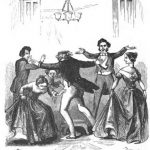 Illuminated manuscripts, especially Medieval works that were written by hand, are always noted for their illustrations and especially the marginalia, those little pictures and abstract designs that form a border around the main text. In a class on medieval literature one of my professors pointed out that the marginalia often illustrate or even supplement the writing, even when the pictures are completely abstract, like the interwoven Celtic designs that appear in some texts. A line that disappears behind a line of a different color, for instance, suggests the movement of the story as well as a transition: just because one line disappears out of sight doesn’t mean it’s out of mind. Parallel or interwoven lines, on the other hand, may suggest similar stories, such as that of Tristan and Isolde which mirrors and foreshadows the tragedy of Launcelot, Guinevere, and King Arthur in Mallory’s Morte D’Arthur.
Illuminated manuscripts, especially Medieval works that were written by hand, are always noted for their illustrations and especially the marginalia, those little pictures and abstract designs that form a border around the main text. In a class on medieval literature one of my professors pointed out that the marginalia often illustrate or even supplement the writing, even when the pictures are completely abstract, like the interwoven Celtic designs that appear in some texts. A line that disappears behind a line of a different color, for instance, suggests the movement of the story as well as a transition: just because one line disappears out of sight doesn’t mean it’s out of mind. Parallel or interwoven lines, on the other hand, may suggest similar stories, such as that of Tristan and Isolde which mirrors and foreshadows the tragedy of Launcelot, Guinevere, and King Arthur in Mallory’s Morte D’Arthur.
Or at least that’s what a lot of modern scholars believe. Since the original illustrators of works like Mallory’s or the Book Of Kells are long gone–or if they’re still around they’re really, really, really old–no one’s able to ask them, and most of the artists who did the work of copying and illuminating manuscripts are anonymous. In the case of works like Beowulf or Sir Gawain & The Green Knight, for that matter, even the authors are anonymous. But there are cases where the correlation between the border designs and the stories seems pretty closely tied.
Anyway I thought about all that when I found this particular work which is really interesting because of its contrast between abstraction and depth, placing different parts in front of each other, and those striking red triangles at either end suggest looking to both the past and future. It doesn’t represent anything recognizable and yet still seems to tell a story–at least that’s what I believe. I assume and hope the artist is still around–this is a pretty recent work, but I have no idea who the artist is or anything about them–whether they’re young or really, really, really old.






This is so fascinating. I love the way you look at things and how reading this will make me look at things in a new way!!!
I’m so glad you enjoyed it. Art, even what some people don’t think of as art, has a way of changing how we understand the world and I enjoy sharing that.
I always love the way you make graffiti relevant!
I love the way you phrase that–I didn’t think of it as “relevant” since I was linking graffiti to traditions that go back a thousand years or more, but, yeah, it really does make it relevant.
Thanks for your in-depth artistry, Chris, as always. I’m also noticing the drawing on the door to the left — I’m choosing to interpret it as “Hate” going down.
Love,
Ann
Hate is indeed going down because I love the way you think.